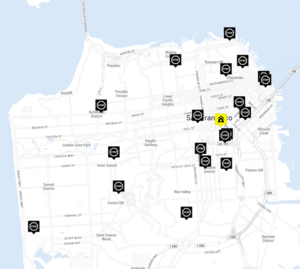Geocoding
To plan a route, the geographical positions of your destinations are required. All your addresses need to be translated to map coordinates. Finding an address on the map is called Geocoding.
Contents
How we geocode
While it should be obvious that each address corresponds with only one position on the planet, in real life it's not that easy. Addresses may be wrong, wrongly spelled, not complete, or not recognized at all, i.e. when they are new or renamed. That makes geocoding a difficult task, one that other services have specialized in.
RouteXL sends your addresses to one of these awesome third-party geocoding services: Bing, Google, Here, Mapbox, Mapquest, Nominatim and Photon. You can select your preferred geocoder in the options. There is no good or bad, each geocoder has its own strengths and weaknesses. Their performance may vary in various regions and with various address format styles.
Hints and tips
To improve geocoding, the first thing you should check is your input. If your addresses are not correct or not complete, finding them on the map will be problematic. Addresses may show up in the wrong place or not at all. Make sure you use the preferred address format.
If your addresses are correct and complete, you can change these settings in the Options to further improve the results:
- Change the preferred geocoder from the dropdown list. Some of the geocoders may set usage limits, as they often offer it as a free service. Selecting another geocoding service may impact address finding drastically.
- Fill out an address suffix. E.g. add your country if you have addresses that have no country. The suffix will be added to all addresses before sending them to the geocoding service.
- Enable precise address checking. You'll get a warning if an address did not provide a exact position, but an approximate, i.e. zip code area.
Location based
If you're in Europe you are probably not interested in addresses in the USA, unless you plan a holiday road trip. RouteXL filters some geocoding results on distance based on your location. Some geocoders use your location to bias the search results. Your location is determined by the map center.
Hint: if addresses are way off, move the map towards the approximate location.
Testing
If you have changed the geocoding options, you can test your settings using the search box. Fill out an address, or a part of it, and wait a few seconds. The search box autocompletion function will display a list of alternative addresses. If these do not appear, or the alternatives are wrong, try other settings for geocoding.
No addresses
The UN estimates that 4 billion people lack a reliable way to address their homes. Poor addressing means deliveries go astray, businesses can’t be found, aid doesn’t get through, remote assets are difficult to manage and friends fail to meet up. What3words gives everyone and everywhere a 3 word address. It’s precise, simple and unique. And it’s changing the way people and businesses talk about location.
RouteXL supports What3words addressing. You can enter the address in the search field or use the Import button. When a 3 word address is detected, the What3words system is called to find its geographic coordinates. Next to that, your locations can be translated to 3 word addresses. To activate the What3words integration use the setting in the Options.
